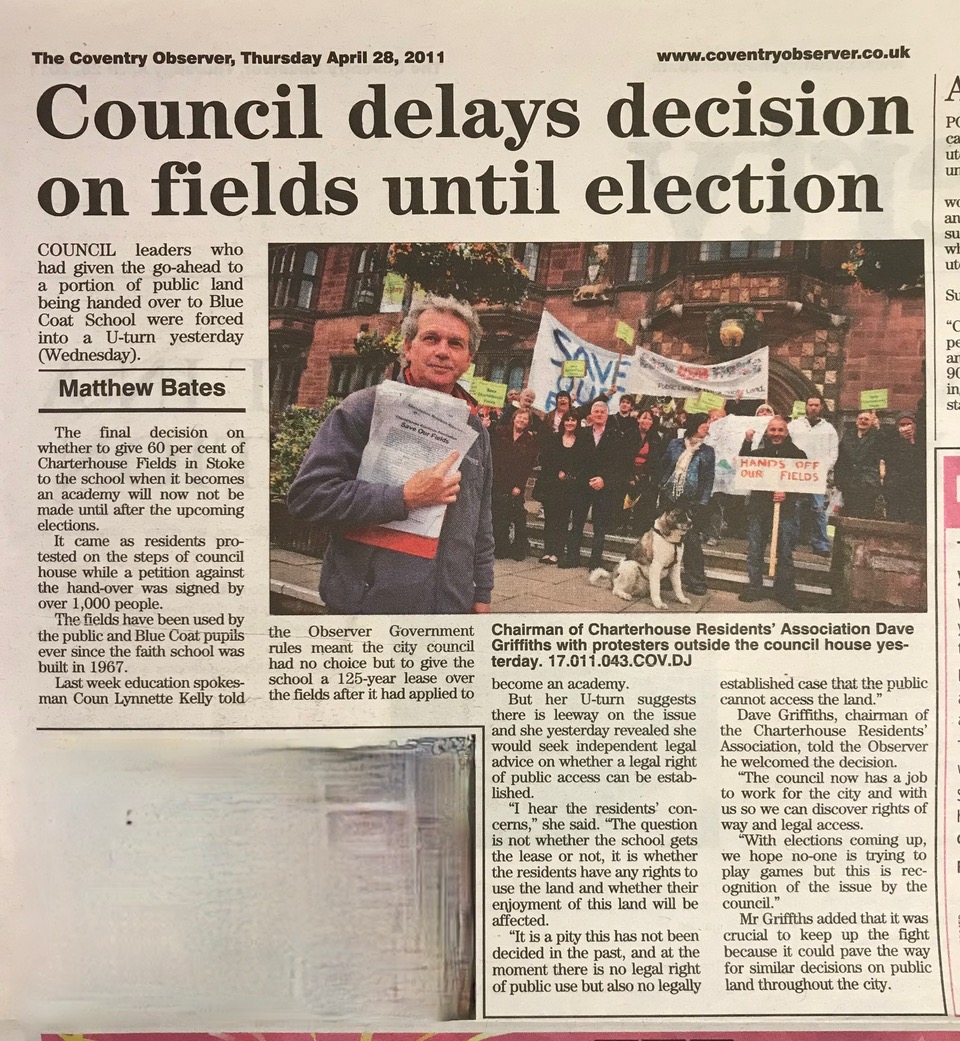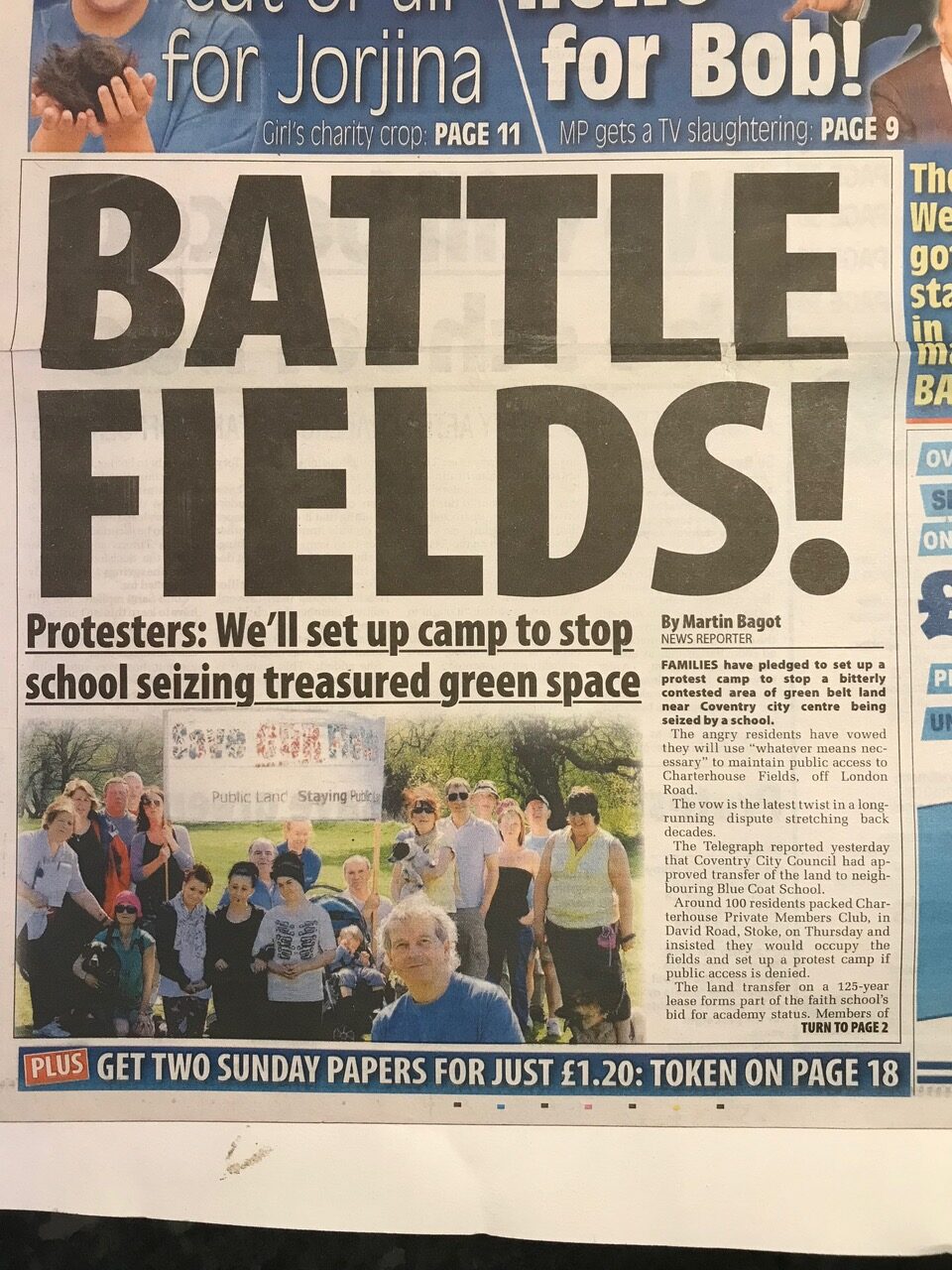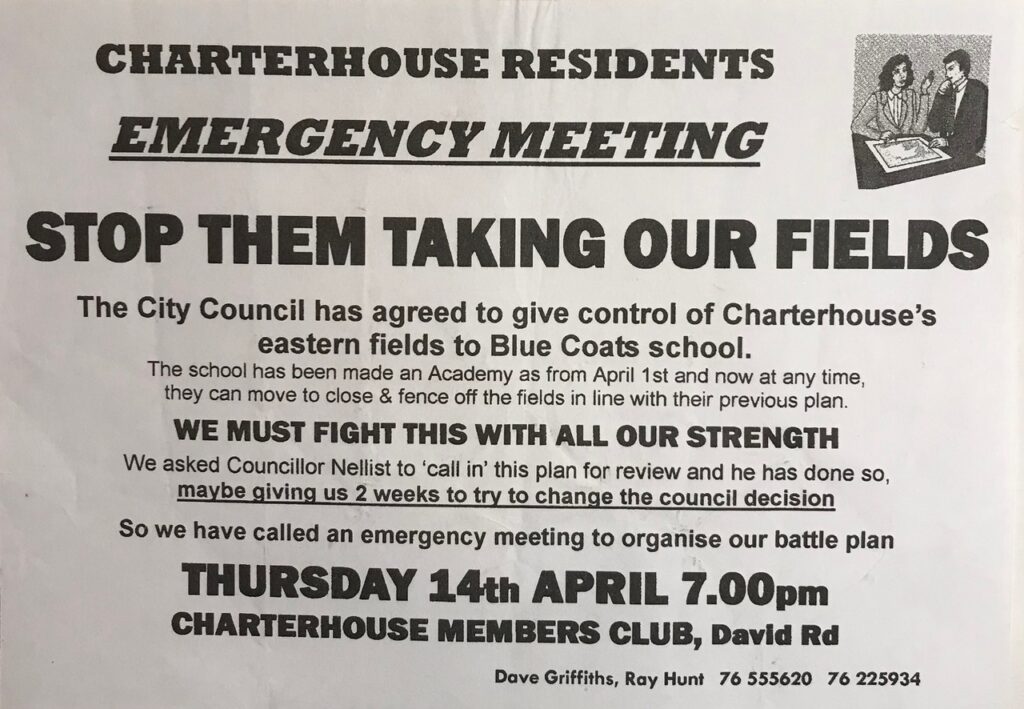With the recent re-opening of the Charterhouse, this article gives a local resident’s description of the fight and campaign to save the building and keep open the public fields. It was adapted from a tape-recorded interview with Dave Griffiths, Chair of the Charterhouse Residents Association, conducted by Nick Le Mesurier. The text has been edited to remove the questions, so please forgive any discontinuities. Dave says…..
It was 1987 when I arrived here with my family; my daughter was five years old, and we just took a walk in the neighbourhood. We wandered into the Charterhouse Field and thought, this is fun! Look at these fields, the fabulous Charterhouse old building. I had no idea how old it was, just that it was old, and such a green space so close to a city centre, and a river, we just thought it was fantastic. I just thought, I’ll happily live around here for a while.
It’s very important to get recent history written down and I am glad to recall how things happened over the building and the land and the heritage park. It will be done by being very positive about it, always emphasising the positive and working in partnership. You don’t get anywhere with negativity. I think it is important to have on record that this has only been possible because there was a fight over this land; there had to be a battle to start to create a partnership that would allow these fields to remain open. Our very firm view is most of those fields would have been fenced off and public access would have been lost forever, which would have been against the intention of Colonel Wyley’s will when he left the land to the city.
The first difficulty was with public access to the Charterhouse fields. It was when the Blue Coats School and the City Council tried to stop dog walkers and two people, Mr Tideswell and Mr Bratby, were prosecuted. Howard Tideswell lived just up the road here. He was a veteran of the car industry, and he knew what standing up for himself meant. He was not going to be intimidated by somebody telling him he couldn’t walk his dog on the field – just for walking, not for fouling because that’s a different matter, but just for being on the land. The prosecution maps had the steps they believed that Tideswell had taken across the field, and the Bratby family who lived in Seagrave Road, and somewhere in all my documents I’ve got the prosecution maps of the terrible crimes committed by Bratby and Tideswell. And just at the last minute the council withdrew the case. All reports said it was obvious that Tideswell and Bratby were going to win. And it was strongly believed therefore that the council withdrew its case so that a legal precedent wasn’t set, because if the judge ruled that, that would have confirmed public access to the fields. But of course, by not ruling it just left it open for them to come back again. So that was the problem.
There was a lady called Gwendolyn Lane who lived just up in Northfield Road here, I’ve found letters that she wrote to the then MP Dave Nellist, asking for support for their work on the fields in the year that Dave was elected in 1983. So really a couple of years before I came here there’d been a previous campaign to resist what they felt was a threat to the access of the fields. And I think there’s a fellow did a lot of local history called Bernard Moore who was supportive of them. And obviously that court case proved that there was a threat to public access across the land.
We managed to raise sufficient funding to get proper footpaths, a children’s playground and benches installed in the fields. All those works meant that the fields got used more and people’s perceptions of safety got better. It was seen as a lovely quiet place to go. There’s enough human use to stop the silly stuff that had been going on for at least a dozen years.
Colonel Wyley had left Charterhouse and the fields to the people of Coventry. He died without an heir because his son was killed in the First World War, and his wife was already dead. A Trust was set up to run the Charterhouse, but over time the councillors were not even aware that they were trustees and left it to council officers to run.
Charterhouse in the 1990s was being used by Tile Hill College for various courses. What really worried us was the fact that the council was seeking to transfer the building to the College. This transfer was being done three or four months before the full implementation of the Conservative government’s policy of privatisation of Technical Colleges. We’d known for years, because I’d seen campaigns in the city by lecturers and others to stop it happening. So, the council transferred the building to Tile Hill College three months before it officially became a private technical college.
The Blue Coats school in 2005 put in an application to put a two-metre-high fence around one of the fields known as the Table Top Field. The local community felt it was public land and protested outside the Council house and put in a ‘Village Green’ and a ‘Right of Way’ application which would have to go to court. Stuart Daniel a lawyer and a member of The Coventry Society gave his time for free to take evidence of people using and walking over the field for many years. This could have involved the city council spending maybe £300,000 to £500,000 in court costs. This is probably what in the end brought all side to the table.



Tile Hill College and the other Technical Colleges in the city combined to become City College, and they built a new City College building near to the Swanswell in Hillfields. They did not need the Charterhouse building anymore and put it up for sale in August 2011. I had come back off holiday and there were ‘for sale’ signs all over the building. We called a residents meeting. ‘We cannot believe this’. I remember that we got Councillor Dave Nellist to ask a question in the council house.
The council took over the building from Wiley in 1940 and had got used to managing it like it was a council asset, but he’d left it to the council as trustees. Dave asked, “when did the trustees of the Charterhouse meet to make this decision?” Because they’ve just done this at an average council meeting. Also there was still the bit in the covenant which said that it should be used not only as a park and a museum but crucially for educational purposes, not just flogging it off. (We heard rumours of a Bangra disco place, and a wedding venue.) Technically it was the college selling for offers above a pound and all the bills. So, who is gonna buy it? – given the roof might cost one and a half million to repair?



Well to me, this is a battle the community should never have had to fight. Why would we have to organise and fight for something the council should have been looking after anyway? (but government cuts do not help). That’s my case and I’m sure others too. But in the end, you know, ‘the only things you have are the things you’ve fought for,’ is not a bad maxim. I think everyone around here is still very proud.
With the help of The Coventry Society the Charterhouse Heritage Trust was set up to run the place starting with only five trustees but with a friends group call Coventry Charterhouse Association which would run the building and keep it clean and open up for various events and meetings while the Trust applied for various lottery grants to get restoration work done. The Association, locals and others would do gardening and clearing away loads of brambles, weed and ivy in the grounds. Slowly the place came to life then when all the funds had been raised the work of restoration began but Covid and price increases of material went up so nothing has been plain sailing.
The Coventry Society had got the City College to put residents to live in the building when it was empty to keep it secure with a scheme run by ‘Adhoc’. They also helped set up the Charterhouse Heritage Trust which later changed to the Historic Coventry Trust to run other historic buildings taking them over from the City Council. The chair is Ian Harrabin; Ian has always been straight with us as a person, and if he disagrees, he will tell you, and you can tell him back and there’s no offence taken.
When we were first drawing up the Charterhouse plans, our opening paragraphs were, “this is an area of unskilled or semi-skilled workers, relatively poor area, and high levels of deprivation.” And yet we used to make the point: here we are, we’re in a triangle where Bolingbroke was due to fight Norfolk and Richard II had to come and stop them, where you’ve got the Charterhouse building over there, you’ve got the Civil War trenches, you’ve got mega-history within a mile, and how that would improve their self-esteem. They could say, we come from a place that mattered, we’re not from this dump of an estate.
So, it was always about changing the lives of so many local young people and give them a far more positive and confident outlook on life. One day we had a crèche on for some event that was on in town, some trade union rally or something like that, and we had about 30 kids, and we went down the fields and after about 20 minutes of kids playing pooh-sticks, and who’s stick’s in the lead, and all that, for some reason someone was in the Charterhouse building and we just went in and we didn’t take them upstairs, just into the back garden and into the wall. And I said, kids, this will be yours to protect in 30 years. You know look at this. Who would have thought we would be in a building like this? And it sounds a silly thing, but you could see them swelling up. So that’s what this could do all across the city, it’s a connection with history and what goes on.
If I look back to 2010 or 2011, we were almost counting the months before we’d be excluded from the fields. Since then, we’ve learnt so much more. I mean we are looking at nature studies that have come in now and ecology reports, because we’ve built up now such a database, getting all the various dog walkers to get their photographs together of the different birds they’ve seen so we can show what’s in there. We’ve got White Egrets down there, marching up the river. And there’s definitely sparrow hawks and buzzards. So, there’s got to be a good diversity of food for them, hasn’t there? The river has got to be reasonably clean for them to come at all.
I think it’s fantastic. I think, what happens with the Charterhouse is that it gives people the encouragement that this can be done elsewhere. We all know we need more houses, we’re not arguing about that, but you’ve got to have space to be human beings again. And having a river and all that space, there ain’t many cities that have got such an asset. Probably Glasgow maybe has decent parks and decent green spaces but it’s fantastic to have it so close.
We think the car park is a monstrosity; it’s opposite the junior school, and it’s at least double in size. What we’d like to see is more people using the facility so as to support the maintenance of the building and the facilities but without it ceasing to be a nice quiet area to go to. But we’re going to have to compromise a bit if we can’t get enough people coming in to finance it and still have it as a lovely quiet place that only we enjoy! So, we all accept that. I’m sure we’ll have these disagreements, but at least you feel you can be in a serious dialogue with the Trust. Whereas the years of our experience with the council is that the residents don’t trust them because they batted with the school. Look, we don’t object to them supporting a school, because they’ve got to support a local school, but once it becomes an academy – I mean when the school became an Academy it broke away from the local authority family, out of local control. Hopefully this is getting better.
I want to go and sit in that nice cafe and have a nice cool beer on a hot summer’s afternoon while my dog is running around the field.
Dave.
